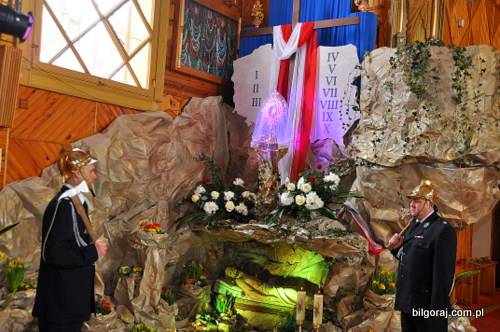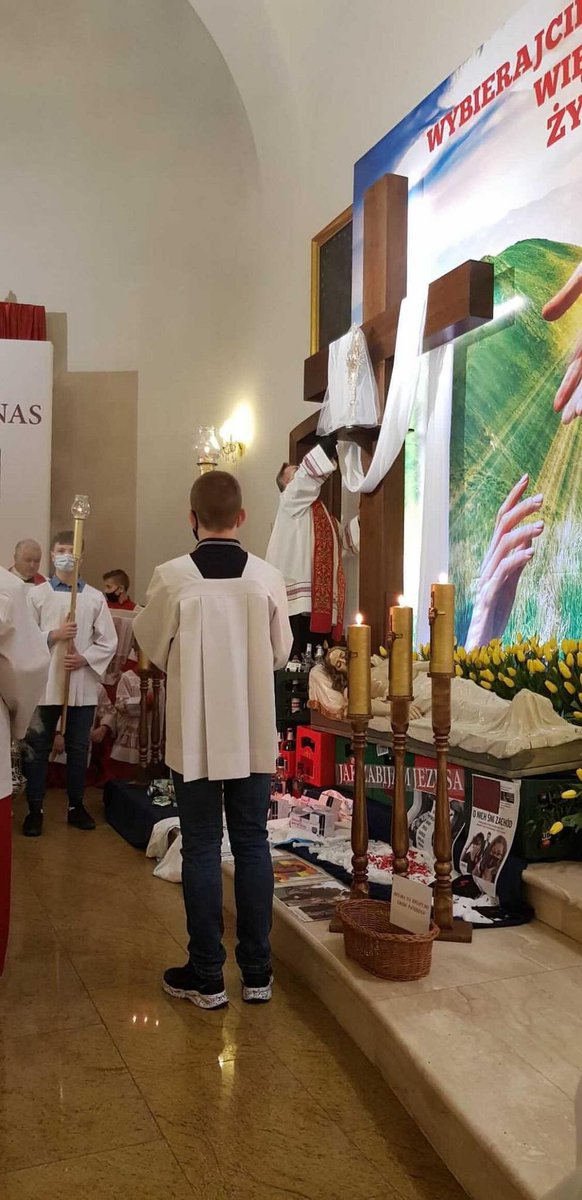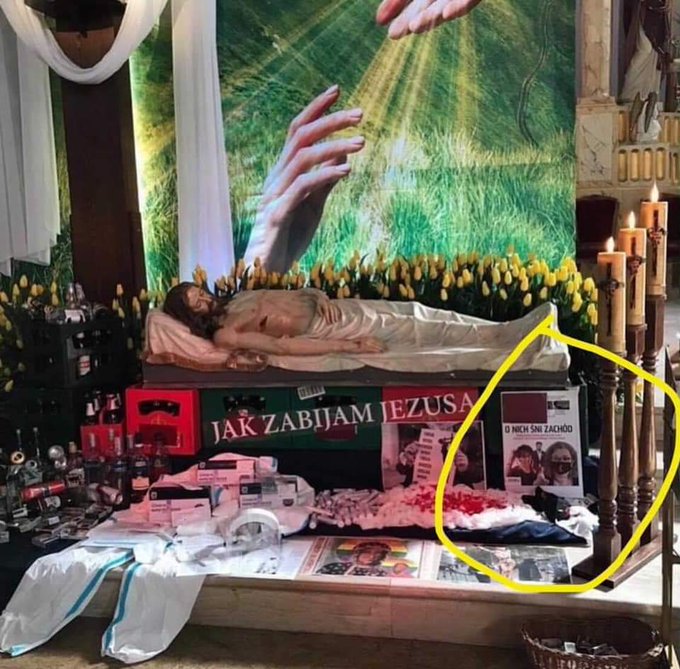|
|
Post by Bonobo on Apr 23, 2011 18:31:16 GMT 1
Lord`s graves in churches at Easter time are mostly traditional, with the cave and a lot of flowers etc.   
but sometimes they represent the current reality. This year they allude to the 2010 air crash in which the President was killed.
Some graves are very controvercial and cause local or national scandals e.g., in Kcynia - a crashed car with blood traces:
|
|
glee ♥
Just born
 XOXOXO
XOXOXO
Posts: 138
|
Post by glee ♥ on Apr 23, 2011 20:21:29 GMT 1
I saw in news this photos. For me it's terrible to show Jesus in the car with a drip. It's a little unpalatable. I think I'll stay home in Dyngus Day because I was sick and I don't want to be again. I was today with my basket in the church  |
|
|
|
Post by Bonobo on Apr 23, 2011 20:29:50 GMT 1
|
|
|
|
Post by Bonobo on Apr 24, 2011 14:19:10 GMT 1
|
|
|
|
Post by valpomike on Apr 24, 2011 16:32:40 GMT 1
Sometimes we don't understand the message sent, but it must have been without good thinking. We all make errors, but this should not change our life styles.
Mike
|
|
|
|
Post by valpomike on Apr 25, 2011 16:21:49 GMT 1
Was not that car, in the photo, German? Why not a Polish car, if you must use this type of display?
Mike
|
|
|
|
Post by Bonobo on Mar 27, 2016 13:48:26 GMT 1
|
|
|
|
Post by Bonobo on Apr 13, 2017 16:08:57 GMT 1
|
|
|
|
Post by Bonobo on Apr 4, 2021 11:41:17 GMT 1
Some graves are very controvercial and cause local or national scandals e This year this grave makes the headline: slogan - How I kill Jesus, with pictures of LGBT and feminist activists, medical ant-virus suit, vaccine packets. Very strange, indeed.   |
|
|
|
Post by Bonobo on Apr 17, 2022 10:46:22 GMT 1
|
|
|
|
Post by jeanne on Apr 17, 2022 19:30:40 GMT 1
I have looked at the images on this entire thread many times, and strangely (for someone like me who is detail-oriented), I never before noticed the monstrances with the Blessed Sacrament. But today, when I was looking at the latest images with the Ukrainian war themes, I noticed them right away. Going back, I looked at all the earlier postings to see if they too had the monstrances, and this time I did see them. Very strange...
|
|
|
|
Post by pjotr on May 28, 2022 9:33:38 GMT 1
Bo, Wonderfull thread this one. Illustrative and detailed images. Thank you for this Report Bo and thank you for your reply. Pieter from an increasingly secularised Netherlands where churches are demolished or become hotels, concert halls, skating halls or apartment buildings or health care centres. Only the Dutch Bible Belt is stil predominantly Christian. And maybe some Roman Catholic enclaves in the South and the Roman Catholic fishermen town Volendam in the North-West in North Holland. When I look at all these Polish Roman Catholic tradiotions, religious days like Christmas, Pentecost, Easter, the Feast of the Ascension and the Assumption of Mary, and the Holy mass and the Catholic community life, the 7 sacraments, and the rich Roman Catholic pillar we had in the 19th and 20th centuries (from the 19th century until halfway the sixties) we have lost a religious life, spirituality, Catholic values, the beauty of Catholic life, rituals, community, culture and education, a lot is lost in the Netherlands. The Rich Catholic pillar had it’s churches, cathedrals, Basilicas, Prince Bishop pallaces, monasteries, universities, kindergarten, primary schools, highschools, Boarding schools, monasteries, poltical party ( en.m.wikipedia.org/wiki/Catholic_People%27s_Party ), Catholic Union ( en.m.wikipedia.org/wiki/Dutch_Catholic_Trade_Union_Federation ), the Catholic Workers Movement (Katholieke Arbeidersbeweging, KAB), Catholic Radio & TV Broadcast Corporation KRO-RKK ( en.m.wikipedia.org/wiki/Katholieke_Radio_Omroep ). Today Roman-Catholicism enters the Netherlands with Roman-Catholic migrants from Poland and other Roman-Catholic countries. It is common that there are several masses in a Dutch Roman Catholic Church each Sunday and probsbly also on other days. For instance Polish mass at 9:00 AM and Dutch mass at 11:00 AM and another mass at 16:00 hours PM. The Dutch Roman Catholic parishes are struggling to survive and suffer from aging. Younger generations don’t go to church, only great grandparents, grandparents and some parents. Secularisation, Sport on Sunday, Secular culture and Music, Social life (Social gathering), nature (walking and cycling in parks and forests) and one day trips in the Netherlands, Belgium, England and other places seem to have replaced Holy mass, communion and thus Roman-Catholic spiritualism. The secularisation process started in the sixties. If you look at countries like Ukraine, Russia, Poland and Greece I see that the secularisation despite or maybe due to Communist atheism hasn’t decreased but stayed similar. Christian traditions, customs and religious life seem to be stronger rooted there and recent suffering maybe gave people comfort and power in Christianity and the suffering of Christ? Pieter Cheers, Pieter |
|
|
|
Post by jeanne on May 29, 2022 0:44:41 GMT 1
When I look at all these Polish Roman Catholic tradiotions, religious days like Christmas, Pentecost, Easter, the Feast of the Ascension and the Assumption of Mary, and the Holy mass and the Catholic community life, the 7 sacraments, and the rich Roman Catholic pillar we had in the 19th and 20th centuries (from the 19th century until halfway the sixties) we have lost a religious life, spirituality, Catholic values, the beauty of Catholic life, rituals, community, culture and education, a lot is lost in the Netherlands. The Rich Catholic pillar had it’s churches, cathedrals, Basilicas, Prince Bishop pallaces, monasteries, universities, kindergarten, primary schools, highschools, Boarding schools, monasteries, poltical party ( en.m.wikipedia.org/wiki/Catholic_People%27s_Party ), Catholic Union ( en.m.wikipedia.org/wiki/Dutch_Catholic_Trade_Union_Federation ), the Catholic Workers Movement (Katholieke Arbeidersbeweging, KAB), Catholic Radio & TV Broadcast Corporation KRO-RKK ( en.m.wikipedia.org/wiki/Katholieke_Radio_Omroep ). Hello Pieter, What you are saying here is a sad truth in many places in the Western world during our current times. I mourn for the loss of the faith in many countries, as the faith was instrumental in the development of western culture and brought the true, the good, and the beautiful to peoples' live. I appreciate that you recognize what has been lost and acknowledge the value it had (and still has...). I try to combat this loss of moral structure, etc., by embracing the faith and trying to continue the way of life it inspires. Hopefully, we might see the day when people will recognize what has been lost and begin to rebuild culture through one person's life at a time. Jeanne |
|